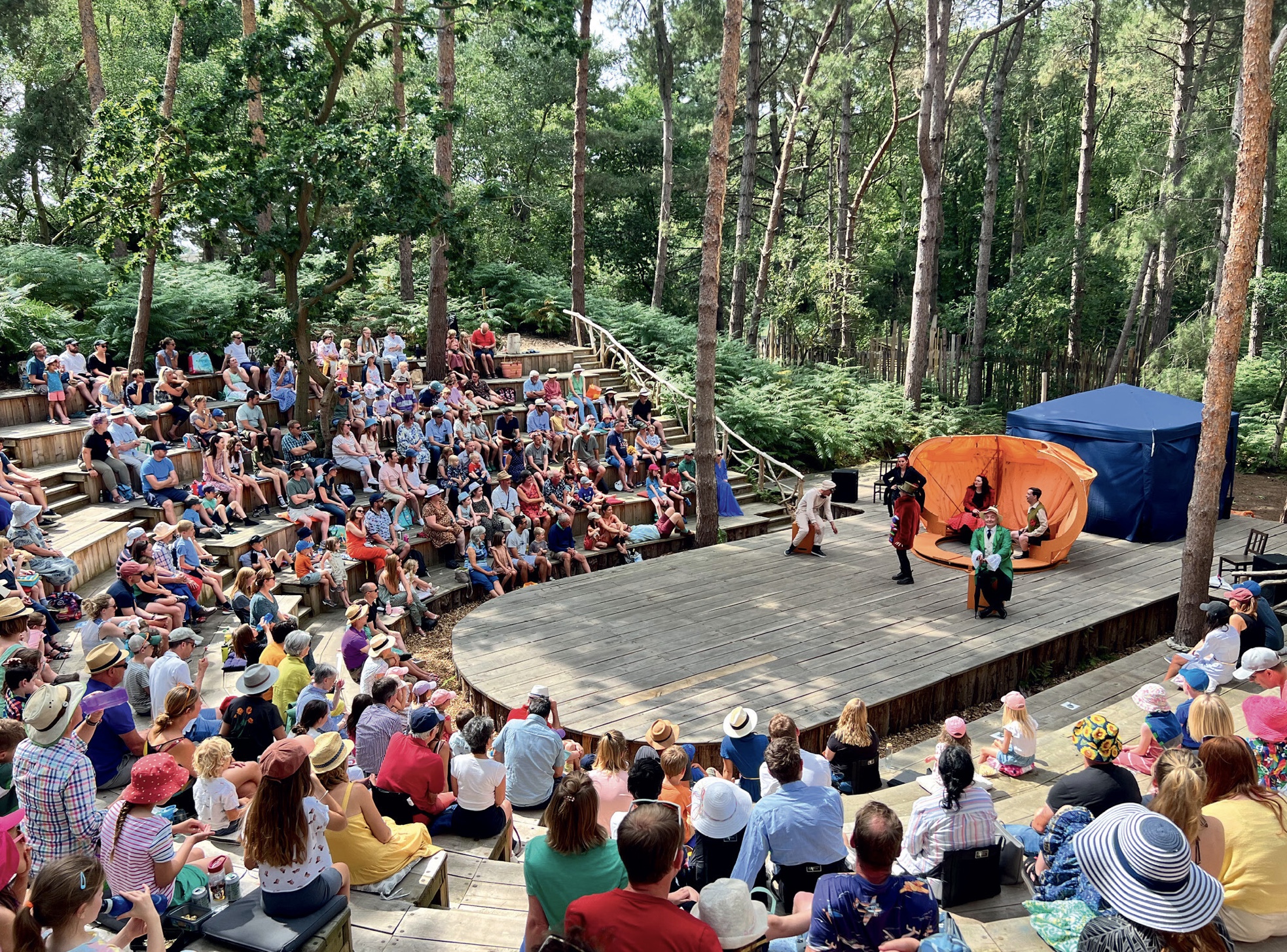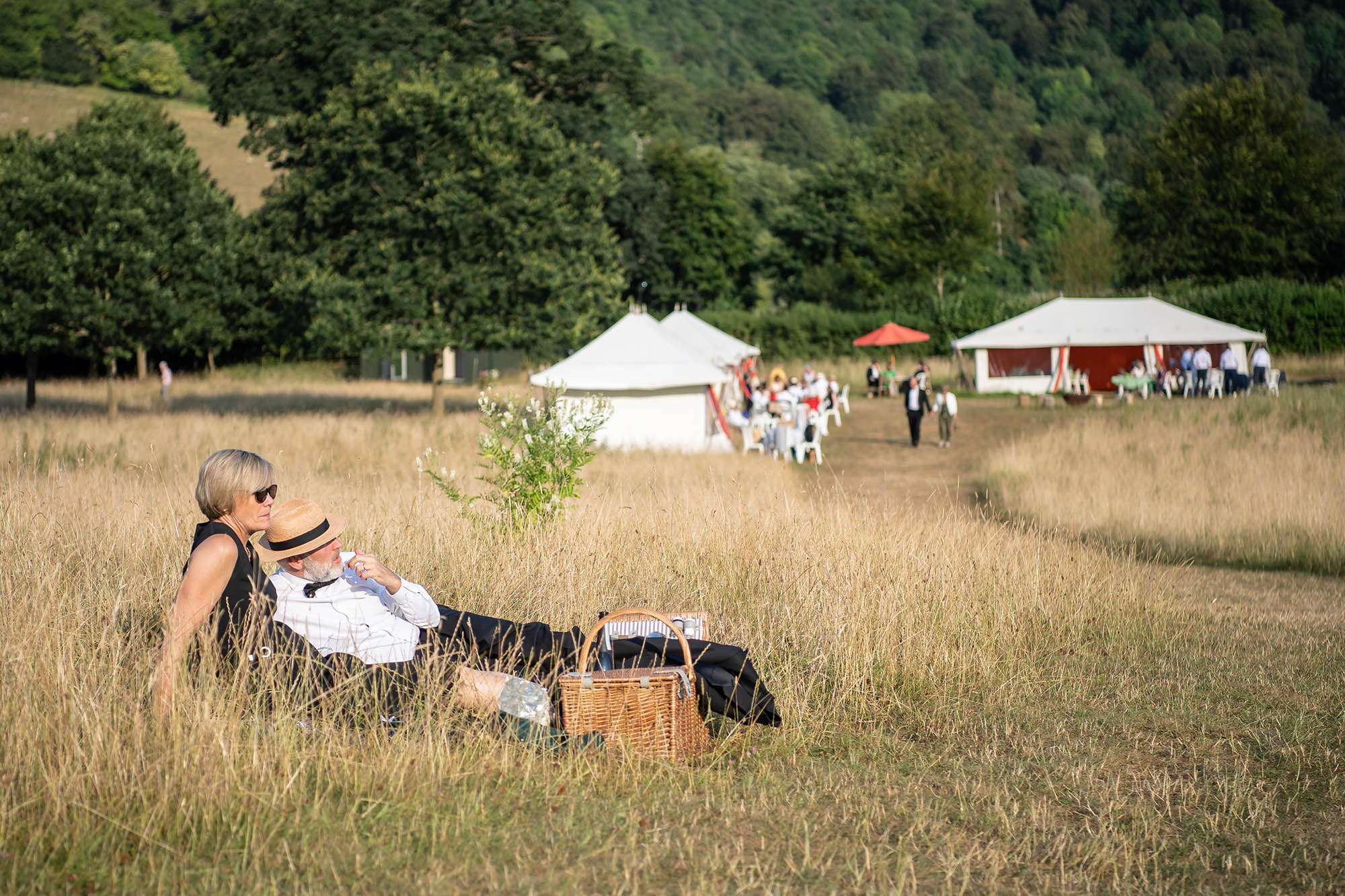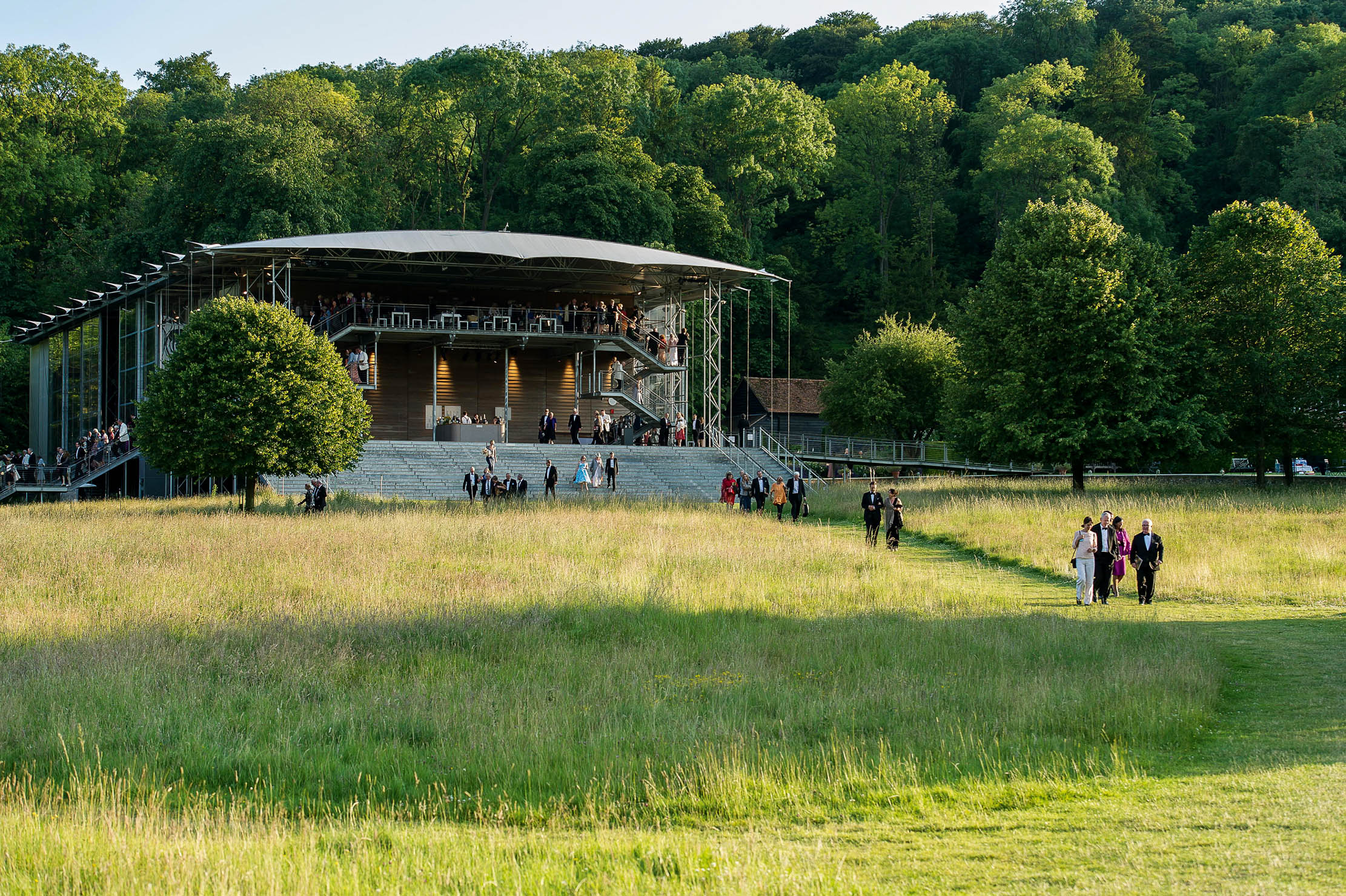Thorington Theatre: How a WW2 bomb crater in Suffolk became one of Britain's most beautiful theatres
Amid the sweet chestnuts, walnuts and cobnuts of a Suffolk farm, a natural amphitheatre has been transformed into a glorious sylvan venue for touring companies to tread Nature’s boards, finds Jo Caird.


The wind is whispering in the pine trees that loom over Thorington Theatre. The stage and seating, built by hand in these woods a few miles from Southwold on the Suffolk coast, are empty, save for a scattering of fallen leaves. In six weeks’ time, however, this sylvan venue will be fizzing with activity, as audience members and performers settle in for the first show of the summer season, by folk act The Trials of Cato. For now, however, all is quiet, the sleeping beauty waiting to be awoken.
The venue is only in its third season of music, theatre, opera, comedy, poetry and storytelling, but it's already earning a spot among the best open-air theatres in Britain, and owner Lindy O’Hare is taking it all in her stride. ‘It’s been a huge learning curve,’ she says. ‘I thought I was a farmer, then, at the age of 60, I’m suddenly running a theatre!’
Mrs O’Hare and her husband, Mark, bought a Grade II-listed farmhouse in 2018, swapping an international finance business in London for a life farming organic sweet chestnuts, cobnuts and walnuts. They immediately noticed the beautiful natural amphitheatre on their land — assumed to be a Second World War crater, created by ordnance dumped by a German pilot on his way home — but it was the tenant of one of their cottages, event designer and carpenter Silas Rayner, who had the idea of making a theatre there.
‘It sounded barking mad, but, after walking past for a couple of months, I said to my husband, “Why don’t we do it?” He’s the one who said: “Yes, we’ll do it with our own timber.”’
Mr O’Hare’s suggestion turned out to be not only a sustainable solution, but a fortuitous one — by the time covid hit a few months later, the O’Hares had all the timber for the 350-seat venue ready and waiting, having been coppiced and milled on site from their own sweet-chestnut trees. As the rest of the country ground to a halt, stuck at home during long weeks of lockdown, Mr Rayner and a small team of carpenters were able to get started on what he calls a ‘dream project’.
The distinctiveness of the site brought particular challenges, from working around the mature trees that give the auditorium its magical atmosphere, to cutting each board by hand to fit the asymmetrical crater. ‘You have to work with the site and the materials,’ explains Mr Rayner. ‘You can’t always make Nature bend to you — you have to bend for it.’
It wasn’t always easy: working on a 30˚ mud slope in all weathers (the build took 14 months), without the help of mechanical digging equipment, was an intense experience at times, Mr Rayner recalls. Yet he wouldn’t have had it any other way. ‘Sometimes, to appreciate a really good day at work, you have to have first had a really bad day at work,’ he notes. ‘For me, it’s part of life, experiencing the good and bad bits.’
Exquisite houses, the beauty of Nature, and how to get the most from your life, straight to your inbox.
It all went remarkably smoothly from Mrs O’Hare’s perspective: ‘The biggest hitch was snow in February. It stopped work for more than a week, but it looked so beautiful.’
As the build neared completion in the spring of 2021, Mrs O’Hare turned her attention to programming a season of work, approaching some schools and local theatre companies to see if they’d like a slot. With no prior experience in the Arts, she relied upon her instincts and some sound advice from the team at the Minack, the cliffside theatre that has been entertaining audiences on the Cornish coast since 1932 (see box). Even so, everyone Mrs O’Hare approached turned her down, citing financial and logistical constraints.
Then, in a stroke of good fortune, local media got wind of the project. ‘All these outdoor-theatre and touring companies, of which there are many around the country, hadn’t worked for two years,’ she says. ‘They inundated us.’
The debut performance was A Midsummer Night’s Dream, by a local children’s theatre group. It rained that night, but no one minded in the slightest, such was the momentousness of opening the theatre amid all the additional stresses of the pandemic (social-distancing requirements meant audiences were limited to 200 at first). ‘It was absolutely thrilling,’ remembers Mrs O’Hare. ‘I was crying — it was a kind of relief.’
That first season, Thorington welcomed audiences totalling 8,300. Last year, operating at full capacity, that rose to 11,000. Mrs O’Hare is hopeful this year will see similar numbers: ‘People still seem to want to have a day out, even if there is a cost-of-living crisis.’
On clifftops and riverbanks
- Theatre enthusiast Rowena Cade built the extraordinary Minack Theatre by hand, carving its seating from the rock of her cliff-top garden in Porthcurno, Cornwall. The site is open daily, with theatre, music and comedy being performed most evenings, plus daytime storytelling for families (01736 810181; www.minack.com)
- Waterside performances are held at the Pitlochry Festival Theatre in Perthshire. A beautiful 80-seat amphitheatre opened in the venue’s lovely gardens, on the banks of the River Tummel, in 2021, alongside two indoor auditoriums (01796 484626; www.pitlochryfestivaltheatre.com)
- Powys, Wales, is home to the Willow Globe, a scaled-down version of Shakespeare’s Globe. The living structure, with willow walls that creak and rustle with every breath of wind, hosts twists on Shakespeare, storytelling and music (01597 811487; www.shakespearelink.org.uk)
She sees every show, from edgy comics such as Rosie Jones (August 16) to operas, including Mozart’s The Magic Flute (August 20) — the only ones she’s missed so far clashed with her son’s wedding. ‘What else would I do? Go out to lunch and do yoga? I don’t want to be anywhere but here,’ she states, gesturing to the peaceful auditorium.
Companies and artists that have performed here share her enthusiasm. ‘Thorington Theatre has an in-built magic that focuses the audience and artists in a very special way,’ believes Bobby Delaney, managing director of The Duke’s Theatre Company, which returns this summer with Twelfth Night (July 15–16). ‘There’s a razor-sharp energy about the place that only happens with true sharing. A rolling laugh in there is electrifying.’
There’s still plenty to do before those laughs can ring through the trees again. Mrs O’Hare’s team, now led by theatre manager Oscar Brennecke-Dunn, is busy reinstalling lighting and technical equipment, spreading woodchips on the paths and power washing a winter’s worth of moss from the stage. Soon, the farm’s horses will be moved to their summer field to make way for the car park, the outdoor bar restocked with locally sourced drinks and snacks and the artists’ green room — a shed in the woods — will be a cosy refuge once more.
Mrs O’Hare can’t wait. ‘Most of the time, I feel I’m hanging on to the back of a runaway train, trying to steer it,’ she reflects. ‘I’m getting everything organised and I don’t know if it’s going to work, but it has worked. It’s been a thrilling ride.’
Thorington Theatre, near Southwold, Suffolk (www.thoringtontheatre.co.uk)

Glyndebourne, Garsington and The Grange among the summer outdoor operas going ahead in Britain this year
Glyndebourne 2021 and several of the other open-air opera events that are such a feature of the British summer are

The 2023 summer outdoor opera season: Where to go, who to watch, and what to put in your picnic hamper
Henrietta Bredin, deputy editor of Opera magazine, shares her tips on how to make the most of the outdoor opera
Country Life is unlike any other magazine: the only glossy weekly on the newsstand and the only magazine that has been guest-edited by His Majesty The King not once, but twice. It is a celebration of modern rural life and all its diverse joys and pleasures — that was first published in Queen Victoria's Diamond Jubilee year. Our eclectic mixture of witty and informative content — from the most up-to-date property news and commentary and a coveted glimpse inside some of the UK's best houses and gardens, to gardening, the arts and interior design, written by experts in their field — still cannot be found in print or online, anywhere else.
